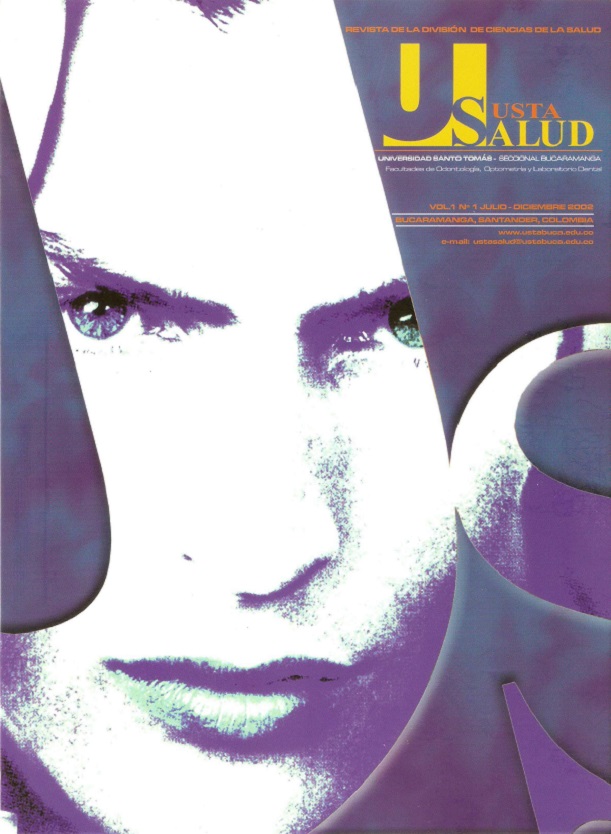MANEJO DEL COMPORTAMIENTO DEL PACIENTE NIÑO EN LA CONSULTA ODONTOLÓGICA
Resumen
El manejo del comportamiento en odontología pediátrica refleja una relación continua entre el niño, sus padres y el odontólogo. Su objetivo es disminuir el miedo y la ansiedad promoviendo un proceso de entendimiento. El propósito de este documento es presentar algunas de las técnicas de manejo más usadas durante la consulta pediátrica.
[Torres EA, Rodríguez MJ, Cañón OL. Manejo del comportamiento del paciente niño en la consulta odontológica. Ustasalud 2002; 1: 49 - 56]
Referencias
2. Sawtell DO, Simon JF, Simonsen FJ. The effects of five preparatory methods upon child behavior during the first dental visit. J Dent Child 1974; 41: 367- 370.
3. Nathan JE. Managing behavior of precooperative children. Dental Clin N Am 1995; 39: 789 - 815.
4. American Academy of Pediatric Dentistry. Guidelines for behavior management. Pediatr Dent (Spec Iss) 2001; 22: 47 - 51.
5. Carr KR, Wilson S, Nimer S, Thornton JB. Behavior management techniques among pediatric dentists practicing in the southeastern United States. Pediatr Dent 1999; 21: 347 - 353.
6. Pinkham JR. Personality development and managing behavior of the cooperative preschool child. Dental Clin N America 1995; 39: 771 - 787.
7. Musselman RJ. Considerations in behavior management of the pediatric dental patient. Pediatr Clin N Am 1991; 38: 1309 - 1324.
8. Weinstein P, Nathan J. The challenge of fearful and phobic children. Dental Clin N Am 1998; 32: 667 - 692.
9. Grinberg S, Schor M. First encounter of child and dentist: An analysis of the introductory session. J Dent Child 1984; 51: 438 - 440.
10. Cárdenas D. Conducta y manejo del paciente niño. En: Fundamentos de Odontología: Odontología Pediátrica. Medellín: CIB, 1996; 22 - 29.
11. Pinkham J. Voice control. An old technique reexamined. J Dent Child 1985; 52: 199 - 202.
12. Cárdenas JM. Pautas para el manejo no farmacológico del comportamiento en el paciente pediátrico. Revista Academia Colombiana de Odontología Pediátrica 1997; 1: 30 - 34.
13. Steelman J. Age and sex predilection of unmanageable Hispanic pediatric dental patients. J Dent Child 1991; 58: 229 - 232.
14. Mathewson RJ, Primosch RE. Behavior management. En: Fundamentals of pediatric dentistry. Third Ed. Carol Stream: Quintessence Pub. 1995; 137 - 144.
15. Wilson S, Creem J, Coury D, Moursi A. The effect of music distraction on pain, anxiety and behavior in pediatric dental patients. Pediatr Dent 2002; 24: 114 - 118.
16. Ingersoll BD, Nash DA, Camber C. The use of contigent audiotaped material with pediatric dental patients. J Am Dent Assoc 1984; 109: 717-719.
17. Lenis AM, Cárdenas JM. Eficacia clínica de la técnica de distracción contingente con material auditivo en pacientes entre 4 y 5 años de edad. Revista Academia Colombiana de Odontología Pediátrica 2002; 4: 18-24.
18. Melamed BG. A technique for reducing children in dental operatory. Dental Clin N Am 1998; 32: 693 - 704.
19. Sokol DJ, Sokol S, Sokol CK. A review of nonintrusive therapies used to deal with anxiety and pain in the dental office. J Am Dent Assoc 1985; 110: 217 - 222.
20. Choate BB, Seale NS, Parker WA, Wilson CF. Current trends in behavior management techniques as they relate to new standards concerning informed consent. Pediatr Dent 1990; 12: 83 - 86.
21. McTigue DJ. Behavior management of children. Dent Clin N Am 1984; 28: 81 - 93.
22. Levitas TC. HOME - hand over mouth exercise. J Dent Child 1974; 41: 178 - 182.
23. Barton DH, Hatcher E, Potter R, Henderson HZ. Dental attitudes and memories. A study of the effects of hand over mouth/restraint. Pediatr Dent 1993; 15: 13 - 19.
24. Aes G, Hersch G, Testen R, Wai M. A 20 year perspective on the changing use of hand over mouth (HOM) and restraint in postdoctoral pediatric dental education. Pediatr Dent 2001; 23: 301 - 306.
25. Clair T. Informed consent in pediatric dentistry: A comprehensive overview. Pediatr Dent 1995: 17: 90 - 97.
26. Kuhn BR, Allen KD. Expanding child behavior management technology in pediatric dentistry: A behavioral science perspective. Pediatr Dent 1994; 16: 13 - 17.
27. Braham R, Bogetz M, Kimura M. Pharmacological patient management in pediatric dentistry. An updated. J Dent Child (Spec Iss) 1993; 60: 270 - 280.
28. American Academy of Pediatric Dentistry. Guidelines for behavior management. Pediatr Dent (Spec Iss) 2001; 22: 73 - 78.
29. López CZ. Guía para el manejo del paciente pediátrico bajo sedación interactuada. Revista Academia Colombiana de Odontología Pediátrica 1997; 1: 35 - 40















